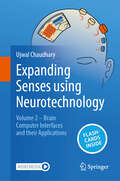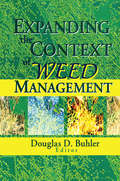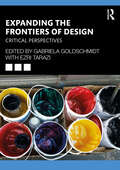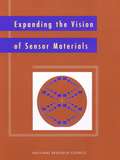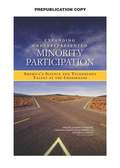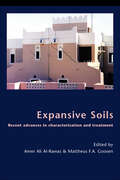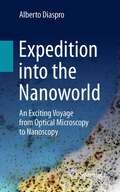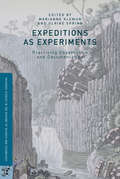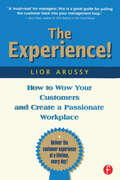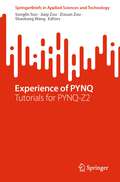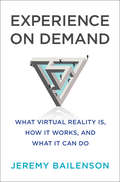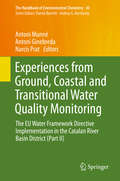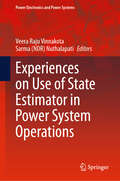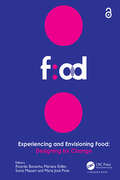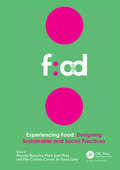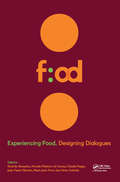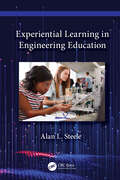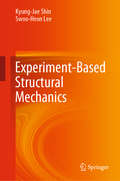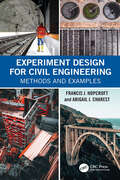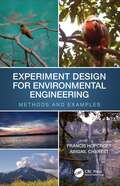- Table View
- List View
Expanding Senses using Neurotechnology: Volume 1 ‒ Foundation of Brain-Computer Interface Technology
by Ujwal ChaudharyThis book is an essential guide for students, researchers, and professionals in the interdisciplinary field of neurotechnology. This comprehensive volume delves into the intricate world of brain signal acquisition, exploring both invasive and non-invasive techniques like EEG, fNIRS, fMRI, and DBS. Through case studies, including groundbreaking communication systems for ALS patients and neurofeedback mechanisms, readers will learn how theoretical concepts are transformed into life-changing technologies. The book traces the historical milestones of neurotechnology and discusses the latest advancements in brain signal processing and neurostimulation techniques. Readers will gain an understanding of how machine learning models enhance neurotechnology applications and how ethical considerations shape the future of this rapidly evolving field. This book offers invaluable insights into the tools, techniques, and applications that are revolutionizing the way we understand and interact with the human brain. Join us on a journey through the past, present, and future of neurotechnology, and discover how this fascinating field is poised to transform healthcare, enhance human capabilities, and improve the quality of life for millions worldwide. This book contains 120 questions and answers: Download the Springer Nature Flashcards App free of charge and use exclusive additional material to test your knowledge.
Expanding Senses using Neurotechnology: Volume 2 ‒ Brain Computer Interfaces and their Applications
by Ujwal ChaudharyThis book provides a comprehensive exploration of the transformative field of brain-computer interfaces (BCIs) and neurotechnology. As the fusion of neuroscience, engineering, and artificial intelligence advances, this textbook guides readers through foundational principles and recent innovations that are reshaping how we understand and enhance brain-body abilities. From non-invasive BCIs and their role in communication and motor restoration to invasive BCIs designed for individuals with locked-in syndrome and beyond, each chapter delves into cutting-edge applications, including neurofeedback therapy and treatments for neuropsychiatric conditions like ADHD and depression. Additionally, the textbook addresses the crucial ethical, legal, and societal implications, exploring concerns over mental privacy, informed consent, and the commercialization of brain data. Intended for students, researchers, and professionals in neuroscience, biomedical engineering, and related fields, this text serves as both a technical guide and an ethical roadmap to the profound future of neurotechnology. This book contains more than 110 questions and answers: Download the Springer Nature Flashcards App free of charge and use exclusive additional material to test your knowledge.
Expanding the Context of Weed Management
by Douglas BuhlerPresents innovative approaches to weeds and weed management. Expanding the Context of Weed Management is your key to the latest economically and environmentally friendly methods of managing weeds. You will explore the biological, cultural, mechanical, and preventive tools and techniques that are necessary to successfully manage weeds. Expanding the Context of Weed Management teaches you how to optimize your crop production and profit by integrating preventive techniques, scientific knowledge, and management skills into your current farming routine. This practical volume contains a series of review articles and original research that present innovative approaches to weeds and weed management. In its pages you will discover valuable and practical information about:how weeds can be considered a part of the cropping system instead of an isolated pest to beeliminatedwhy weeds behave as they doshort and long term approaches to changing weed managementstandard breeding methods for weed competitive cropshow to improve soil quality to manage weedshow to integrate pest management for weedshow to avoid propagule productionhow to reduce weed emergence in cropshow to minimize weed competition with the cropThe costliness of weeds and weed control is more than $15 billion a year in the United States.Expanding the Context of Weed Management will help you cut this cost with the latest methods of effective weed control. Intended for agronomists, weed scientists, crop advisors, environmentalists, students, and crop ecologists,this book provides a successful and environmentally sound perspective on weeds and their control.
Expanding the Frontiers of Design: Critical Perspectives
by Gabriela Goldschmidt Ezri TaraziDesign Thinking, a method widely used in design business and management, has changed the landscape of contemporary design. Whereas in the past non-designers were called upon to serve as external consultants ad-hoc, in an effort to promote creativity and innovation most design teams now consist of a mix of designers and other professionals. The impact of this development on the design landscape in recent years is so far without thorough investigation and analysis of its various influences. This book comprises an edited collection of selected papers from the 13th Design Thinking Research Symposium (DTRS13) which offers an exploration of Design Thinking from theoretical, practical, and pedagogical perspectives as well as critical analysis of the design process. The book is arranged in five parts as follows: Part 1: Thinking about design Part 2: Design thinking in the studio Part 3: Design thinking in practice and professional training Part 4: Design teams of diverse backgrounds, Interdisciplinary projects Part 5: Design and nature; visual representation Providing a comprehensive source for new perspectives on design and Design Thinking, Expanding the Frontiers of Design is ideal for designers and design academics of all disciplines wishing to strengthen and innovate their practice, as well as industry leaders who seek to consolidate their business strategies and evolve their work.
Expanding the Vision of Sensor Materials
by Committee On New Sensor Technologies: Materials ApplicationsAdvances in materials science and engineering have paved the way for the development of new and more capable sensors. Drawing upon case studies from manufacturing and structural monitoring and involving chemical and long wave-length infrared sensors, this book suggests an approach that frames the relevant technical issues in such a way as to expedite the consideration of new and novel sensor materials. It enables a multidisciplinary approach for identifying opportunities and making realistic assessments of technical risk and could be used to guide relevant research and development in sensor technologies.
Expanding Underground - Knowledge and Passion to Make a Positive Impact on the World: Proceedings of the ITA-AITES World Tunnel Congress 2023 (WTC 2023), 12-18 May 2023, Athens, Greece
by Georgios AnagnostouExpanding Underground - Knowledge and Passion to Make a Positive Impact on the World contains the contributions presented at the ITA-AITES World Tunnel Congress 2023 (Athens, Greece, 12 – 18 May, 2023). Tunnels and underground space are a predominant engineering practice that can provide sustainable, cost-efficient and environmentally friendly solutions to the ever-growing needs of modern societies. This underground expansion in more diverse and challenging infrastructure types or to novel underground uses can foster the changes needed. At the same time, the tunneling and underground space community needs to be better prepared and equipped with knowledge, tools and experience, to deal with the prevailing conditions, to successfully challenge and overcome adversities on this path. The papers in this book aim at contributing to the analysis of challenging conditions, the presentation and dissemination good practices, the introduction of new concepts, new tools and innovative elements that can help engineers and all stakeholders to reach their end goals. Expanding Underground - Knowledge and Passion to Make a Positive Impact on the World covers a wide range of aspects and topics related to the whole chain of the construction and operation of underground structures: - Knowledge and Passion to Expand Underground for Sustainability and Resilience - Geological, Geotechnical Site Investigation and Ground Characterization - Planning and Designing of Tunnels and Underground Structures - Mechanised Tunnelling and Microtunnelling - Conventional Tunnelling, Drill-and-Blast Applications - Tunnelling in Challenging Conditions - Case Histories and Lessons Learned - Innovation, Robotics and Automation - BIM, Big Data and Machine Learning Applications in Tunnelling - Safety, Risk and Operation of Underground Infrastructure, and - Contractual Practices, Insurance and Project Management The book is a must-have reference for all professionals and stakeholders involved in tunneling and underground space development projects.
Expanding Underrepresented Minority Participation: America'S Science and Technology Talent at the Crossroads
by National Academy Of Sciences National Academy of Engineering Institute of Medicine of the National AcademiesIn order for the United States to maintain the global leadership and competitiveness in science and technology that are critical to achieving national goals, we must invest in research, encourage innovation, and grow a strong and talented science and technology workforce. Expanding Underrepresented Minority Participation explores the role of diversity in the science, technology, engineering and mathematics (STEM) workforce and its value in keeping America innovative and competitive. According to the book, the U.S. labor market is projected to grow faster in science and engineering than in any other sector in the coming years, making minority participation in STEM education at all levels a national priority. Expanding Underrepresented Minority Participation analyzes the rate of change and the challenges the nation currently faces in developing a strong and diverse workforce. Although minorities are the fastest growing segment of the population, they are underrepresented in the fields of science and engineering. Historically, there has been a strong connection between increasing educational attainment in the United States and the growth in and global leadership of the economy. Expanding Underrepresented Minority Participation suggests that the federal government, industry, and post-secondary institutions work collaboratively with K-12 schools and school systems to increase minority access to and demand for post-secondary STEM education and technical training. The book also identifies best practices and offers a comprehensive road map for increasing involvement of underrepresented minorities and improving the quality of their education. It offers recommendations that focus on academic and social support, institutional roles, teacher preparation, affordability and program development.
Expansive Soils: Recent Advances in Characterization and Treatment
by Amer Ali Al-Rawas Mattheus F.A. GoosenExpansive Soils provides the reader with easy and specific access to problems associated with expansive soils, characterisitics and treatment, and evaluation and remediation. Set up with contributions from worlwide expert, this main reference guide is intended for engineers, researchers and senior students working on soil
Expedition into the Nanoworld: An Exciting Voyage from Optical Microscopy to Nanoscopy
by Alberto DiasproThe story of microscopy over the years is one of wonder, revelation, and even love. What better words could there be to describe the amazing things that we have been able to see, learn and accomplish thanks to the progress made in this field? A love story between a pieace of glass and the rainbow with an original soundtrack mad of poetry and music. From Galilei’s initial foray into basic optical microscopy, including the Camillo Golgi and Giuliano Toraldo di Francia lessons, to such later developments as time-resolved microscopy, multi-photon microscopy and three-dimensional microscopy to innovations such as optical nanoscopy, bioimaging and super resolution imaging, the book seeks to take the reader, be they scientist or layperson, on a journey through the evolution of the microscope and its many uses, including in the field of medicine. The author uses visible light as a through-line to unite the various chapters, as well as using fluorescence as a touchpoint from which to map the changes in the science, a significant choice, as it, along with label-free approaches and the addition of artificial intelligence, form the natural environment for development of the modern multi-messenger microscope towards bioimaging at the nanoscale.
Expeditions as Experiments
by Marianne Klemun Ulrike SpringThis collection focuses on different expeditions and their role in the process of knowledge acquisition from the eighteenth century onwards. It investigates various forms of scientific practice conducted during, after and before expeditions, and it places this discussion into the scientific context of experiments. In treating expeditions as experiments in a heuristic sense, we also propose that the expedition is a variation on the laboratory in which different practices can be conducted and where the transformation of uncertain into certain knowledge is tested. The experimental positioning of the expedition brings together an ensemble of techniques, strategies, material agents and social actors, and illuminates the steps leading from observation to facts and documentation. The chapters show the variety of scientific interests that motivated expeditions with their focus on natural history, geology, ichthyology, botany, zoology, helminthology, speleology, physical anthropology, oceanography, meteorology and magnetism.
The Experience: How to Wow Your Customers and Create a Passionate Workplace
by Lior ArussyA 'must-read' for managers; this is a great guide for pulling the customer back into your management loop.' — Jerry Vass, author of Soft Selling in the Hard World 'Lior Arussy spins a cautionary tale for the transition companies m
Experience from the DARPA Urban Challenge
by Christopher Rouff and Mike HincheyExperience from the DARPA Urban Challenge provides details of the types of systems, software and processes that were used to develop the complex unmanned vehicles that participated in the DARPA Urban Challenge. The vehicle developers explain how autonomous vehicle software in this race was designed and implemented. The chapters range from system and software architecture, navigation, path planning, steering, perception, engineering autonomous systems, and testing and performance evaluation.This book is based on papers from entrants in the Urban Challenge. The content is broken into five parts:an introduction to the DARPA Urban Challenge;systems and software architectures;navigation;control and sensors; anddevelopment and test.Experience from the DARPA Urban Challenge provides graduate students in robotics and engineering professionals with an insight into multiple ways of approaching the development of autonomous vehicles.
Experience from the DARPA Urban Challenge
by Christopher Rouff Mike HincheyExperience from the DARPA Urban Challenge provides details of the types of systems, software and processes that were used to develop the complex unmanned vehicles that participated in the DARPA Urban Challenge. The vehicle developers explain how autonomous vehicle software in this race was designed and implemented. The chapters range from system and software architecture, navigation, path planning, steering, perception, engineering autonomous systems, and testing and performance evaluation. This book is based on papers from entrants in the Urban Challenge. The content is broken into five parts: an introduction to the DARPA Urban Challenge;systems and software architectures;navigation;control and sensors; anddevelopment and test.Experience from the DARPA Urban Challenge provides graduate students in robotics and engineering professionals with an insight into multiple ways of approaching the development of autonomous vehicles.
Experience of PYNQ: Tutorials for PYNQ-Z2 (SpringerBriefs in Applied Sciences and Technology)
by Songlin Sun Jiaqi Zou Zixuan Zou Shaokang WangThis book introduces PYNQ, a Python-based framework from Xilinx® that makes it easier for users to build electronic systems on Xilinx platforms. The book covers the architecture of PYNQ, the design tools and methods, software and hardware design approach, as well as rich experiment cases on communications, multimedia, and deep learning. This book serves as a useful guide for those getting starting with, or working with PYNQ and enables the learners to have a thorough understanding of the hardware/software co-design approaches in the area of the communication, multimedia, and other information system components.This book is organized based on the teaching materials of “hardware comprehensive experiments” which is an experimental course in BUPT, for both undergraduate and graduate students, and domestic and international students. This course has more than ten years of teaching experience and has taught hundreds of students.
Experience on Demand: What Virtual Reality Is, How It Works, and What It Can Do
by Jeremy BailensonAn in-depth look at virtual reality and how it can be harnessed to improve our everyday lives. Virtual reality is able to effectively blur the line between reality and illusion, pushing the limits of our imagination and granting us access to any experience imaginable. With well-crafted simulations, these experiences, which are so immersive that the brain believes they’re real, are already widely available with a VR headset and will only become more accessible and commonplace. But how does this new medium affect its users, and does it have a future beyond fantasy and escapism? In Experience on Demand, Jeremy Bailenson draws on two decades spent researching the psychological effects of VR and other mass media to help readers understand this powerful new tool. He offers expert guidelines for interacting with VR and describes the profound ways this technology can be put to use—not to distance ourselves from reality, but to enrich our lives and influence us to treat others, the environment, and even ourselves better. In the world of VR, a football quarterback plays a game against a competing team hundreds of times before even stepping onto the field; members of the United Nations embody a young girl in a refugee camp going through her day-to-day life; and veterans once again walk through the streets where they had experienced trauma. There are dangers and many unknowns in using VR, but it also can help us hone our performance, recover from trauma, improve our learning and communication abilities, and enhance our empathic and imaginative capacities. Like any new technology, its most incredible uses might be waiting just around the corner. Experience on Demand is the definitive look at the risks and potential of VR—a must-read for navigating both the virtual and the physical worlds ahead.
Experiences from Ground, Coastal and Transitional Water Quality Monitoring
by Antoni Munné Antoni Ginebreda Narcís PratThis book details theexperiences gained by the Catalan Water Agency (ACA) in a Mediterraneanwatershed - the Catalan River Basin District - following the launch of the EUWater Framework Directive (WFD) in the year 2000. Groundwater and coastal waterexperts present 13 chapters defining tools for water-status assessmentspecially adapted to Mediterranean conditions. The content of this and thecompanion volume Experiences from SurfaceWater Quality Monitoring: The EU Water Framework Directive Implementation inthe Catalan River Basin District (Part I) are the result of an excellentcollaboration between the ACA and several Catalan universities and researchcenters to cope with new challenges provided by the WFD monitoring requirements. The volume serves as a useful guide for environmental managers and scientistsengaged in other European as well as Non-European river basins.
Experiences on Use of State Estimator in Power System Operations (Power Electronics and Power Systems)
by Sarma Ndr Nuthalapati Veera Raju VinnakotaThis book brings together successful case studies on the practical use of state estimators at both the transmission and distribution system levels in the power industry. Contributions are written by an international group of utility industry experts who have designed and implemented state estimators for managing their grid operations in real-time, providing readers with a solid background in the theoretical and functional aspects of running, supporting, and maintaining the operation of state estimators on an ongoing basis. Experiences on Use of State Estimator in Power System Operations provides a comprehensive picture of state estimators in a practical setting and is a valuable hands-on reference for system operators and engineers who need to enhance their understanding of the use of state estimation in utility operations.
Experiencing and Envisioning Food: Designing for Change
by Ricardo BonachoExperiencing and Envisioning Food: Designing for Change contains papers on gastronomy, food design, sustainability, and social practices research as presented at the 3rd International Food Design and Food Studies Conference (EFOOD 2022, Lisbon, Portugal, 28-30 April 2022). The contributions explore potential solutions to current problems in the food system, and outline scenarios on the future of food and nutrition. The book aims at academics and professionals that interact with the food sector.
Experiencing Food: Proceedings of the 2nd International Conference on Food Design and Food Studies (EFOOD 2019), 28-30 November 2019, Lisbon, Portugal
by Ricardo Bonacho Maria José Pires Elsa Cristina Carona de Sousa LamyExperiencing Food: Designing Sustainable and Social Practices contains papers on food, sustainability and social practices research, presented at the 2nd International Conference on Food Design and Food Studies, held November 28-30, 2019, at the Faculty of Architecture, University of Lisbon, Lisbon, Portugal. The conference and resulting papers reflect on interdisciplinarity as not limited to the design of objects or services, but seeking awareness towards new lifestyles and innovative approaches to food sustainability.
Experiencing Food, Designing Dialogues: Proceedings of the 1st International Conference on Food Design and Food Studies (EFOOD 2017), Lisbon, Portugal, October 19-21, 2017
by Ricardo Bonacho Alcinda Pinheiro de Sousa Cláudia Viegas João Paulo Martins Maria José Pires Sara Velez EstêvãoFOOD and interdisciplinary research are the central focus of the 1st International Conference on Food Design and Food Studies: Experiencing Food, Designing Dialogues, reflecting upon approaches evidencing how interdisciplinarity is not limited to the design of objects or services, but seeks awareness towards new lifestyles and innovative ways of dealing with food. This book encompasses a wide range of perspectives on the state of the art and research in the fields of Food and Design, making a significant contribution to further development of these fields. Accordingly, it covers a broad variety of topics from Designing for/with Food, Educating People on Food, Experiencing Food and other Food for Thought.
Experiential Learning Design: Theoretical Foundations and Effective Principles
by Colin BeardExperiential Learning Design comprehensively demonstrates the key theories and applications for the design of experiential approaches to learning and training. Learning is gradually moving away from management and delivery of content, and toward experiences that encourage learners to engage and take greater responsibility for their own progress. This book’s empirically sound, multi-disciplinary approach balances technical-rational and artistic-intuitive design elements to accommodate the complex, fluctuating capacities of human learning. In-depth chapters cover design principles, social and environmental factors in learning, the importance of senses and emotions, and links between body and brain. This bold, unique perspective shift will enrich the work of learning scientists, instructional designers, educational technologists, and beyond.
Experiential Learning in Engineering Education
by Alan L. SteeleExperiential Learning presents an evolving form of education that fundamentally involves "learning by doing" and having students reflect on the work. The book discusses these recent developments pertaining to the use of experiential learning in engineering education. Covering a range of innovations in experiential learning, the book explores development in laboratories, in-class and problem-based learning, project work and society-based aspects, including Indigenous elements in the curriculum. It includes case studies and examples sourced from institutions around the world. Features Focuses on recent and practical aspects of implementing experiential learning to help improve engineering education Offers an examination of the undergraduate experience, which leads to professional certification Includes a chapter on lessons in other professional education areas, such as medicine and health care, business and social work A broad readership will find value in this book, including faculty who teach undergraduate engineering courses, engineering education researchers, industry partners that provide co-op experience and developers of training modules for practicing engineers.
Experiment-Based Structural Mechanics
by Kyung-Jae Shin Swoo-Heon LeeThis textbook demonstrates theoretical principles and actual cases of structural mechanics. This book explains basic definitions of beam, frame, and truss which are widely used in the field of structure mechanics and also shows important engineering tests such as moment distribution, characteristics of member section, analysis of a truss, analysis of a statically indeterminate structure, and principle of bending resistance of concrete section. These contents can help many students to figure out the resistance principle of a structure through simple model tests, dynamics, reinforced concrete structure, steel frame structure and understand how dynamic computational equation is mathematically used in structure mechanics.
Experiment Design for Civil Engineering: Methods and Examples
by Francis J. Hopcroft Abigail J. CharestExperiment Design for Civil Engineering provides guidance to students and practicing civil engineers on how to design a civil engineering experiment that will produce useful and unassailable results. It includes a long list of complete experiment designs that students can perform in the laboratory at most universities and that many consulting engineers can do in corporate laboratories. These experiments also provide a way to evaluate a new design against an existing experiment to determine what information is most appropriate in each section and how to format the data for the most effective outcome. Interpretation of output data is discussed, along with uncertainty, as well as optimal presentation of the data to others. The content of the first 8 chapters is similar in format to authors' recent title, Experiment Design for Environmental Engineering: Methods and Examples (CRC Press, 2022) and has been revised for civil engineers. This textbook: Fills in the gap in ABET requirements to teach experiment design. Provides a standardized approach to experiment design that can work for any experiment. Includes completed experiment designs suitable for college laboratory and professional applications. Shows how to organize experimental data as it is collected to optimize usefulness. Provides templates for design of the experiment and for presenting the resulting data to technical and nontechnical audiences or clients.
Experiment Design for Environmental Engineering: Methods and Examples
by Francis J. Hopcroft Abigail CharestExperiment Design for Environmental Engineering provides a wide range of practical environmental engineering laboratory experiments for implementation by students in a university laboratory or by practicing professionals in the field, along with an extensive discussion on how to design an experiment that will provide meaningful and useful data, how to interpret the data generated from an experiment, and how to present those data to an audience of other students or professionals. The example experiments provide a way to evaluate a new design against an existing experiment to determine what information is most appropriate in each section and how to format the data for the most effective outcome. Features Fills in the gap in ABET requirements to teach students how to design experiments and includes key elements for a successful design Covers experiments for a wide range of environmental engineering topics Provides standardized approach that includes a basic background to the concepts and step-by-step procedure for conducting the experiment Explains designs that are suitable for college laboratory and professional applications Shows how to organize experimental data as it is collected to optimize usefulness Provides templates for design of the experiment and for presenting the resulting data to technical and nontechnical audiences or clients

